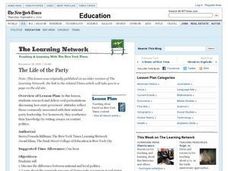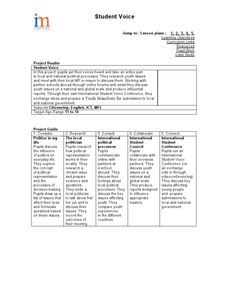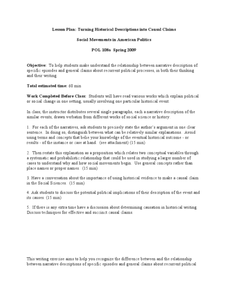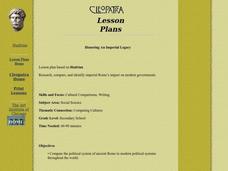Curated OER
Map It!
Fourth graders collect and explore different maps and their uses before using the program Pixie to create maps of geographic features, political features, and economic information for the state in which they live.
Curated OER
Campaign Songs as Propaganda
Student analyze campaign messages about tariffs in a nineteenth-century campaign song. They identify the intended audience of the message. They discuss strategies for courting the other political party's bloc.
Curated OER
1960 Election
Learners examine the election of 1960. For this US politics lesson students listen to a teacher driven lecture, take notes, engage in a class discussion and write a response to what they have learned regarding the 1960's presidential...
Curated OER
The Life of the Party
Students research and deliver oral presentations discussing how state governors' attitudes reflect those commonly associated with their national party leadership. They synthesize their knowledge by writing essays on centrist politics.
Curated OER
Them Damned Pictures
Young scholars examine and gather information from primary sources about events during the Revolutionary War. They identify and place the political cartoons. They respond to a cartoon from the point of view of someone who lived at the time.
Curated OER
Index Card Jigsaw
Students explore accomplishments of historical figures. Through participation in a hands-on activity, teams of students match names, quotes, views and political party affiliation to the correct picture. They create a chart from the...
Curated OER
Promoting the Candidate
Young scholars identify the role of political parties in presidential elections, then interpret objects from presidential campaigns.
National First Ladies' Library
Presidential Campaigning--Front Porch Style
High schoolers compare and contrast "front porch" political campaigns and modern day traveling campaigns of past presidents. Using the internet and other sources, they explore President Harding's campaign and platform. Using the internet...
Curated OER
Cities of the World
Students identify the symbol for cities on a political map. In this world map lesson, students identify specific cities on the World Political Map. Students should identify the country in which the city is located. Students discuss the...
Curated OER
Student Voice
Students investigate local and national politics. They research youth issues through online forums and e-mail while working with a partner. They participate in their own conference to prepare a Youth Manifesto to be submitted.
Curated OER
Select-a-Lawmaker
Students are assigned a party faction, examine bills voted on by their party faction last year, and find a candidate with a similiar view of government.
Curated OER
911 As History
Students recognize persuasive techniques, think criticaly about the messages contained in various media, and discuss controversial issues in constructive ways. They analyze the deeper messages contained in children's literature, and...
Curated OER
Historical Witness: Social Messaging
Students examine the persuasive techniques of leaders. In this propaganda lesson, students discover the practices that Louis XIV and Caligula used to persuade others. Students watch "The Merchants of Cool" and discuss propaganda used...
Curated OER
Turning Historical Descriptions into Causal Claims
Eleventh graders study different political processes. In this American Government lesson, 11th graders read narratives about different political processes. Students write a sentence in their own words describing the concepts.
Curated OER
Honoring An Imperial Legacy
Students research, compare, and identify imperial Rome's impact on modern governments. They compare the political system of ancient Rome to modern political systems throughout the world.
Curated OER
Lessons from the Holocaust - Hitler Youth
Students examine the political socialization that contributed to the Holocaust. In this Holocaust activity, students read about supporters of the Nazi party and how political socialization led to the Hitler Youth.
Curated OER
How We Got to Kansas-Nebraska
Learners explore the causes of the Civil War. In this lesson on slavery students use primary sources to examine the evolution of the issue of slavery and in the American political system. Learners will then write a follow-up essay that...
Curated OER
Party Like It's 1992 or '84 or '76 or '68!
Students explore, analyze and study how political party platforms have changed over time. They create a party platform time line by researching Republican and Democratic Party stances on various issues during the last few decades.
Curated OER
Wall of Respect
Students demonstrate respect. In this character education instructional activity, students discuss how to be respectful to adults and to peers. Students draw a picture of being polite or showing respect to a peer. Students place their...
Curated OER
Hillary Clinton's Voting Record Distorted
Learners examine how political advertisements can be used to deliver messages and stir emotions. Using a political ad from the 2006 Senate election, students generate questions based on the claims in the ads. They research information to...
Curated OER
Editorial Cartoon: Censorship
Students explore the concept of juxtaposition. In this editorial cartoon lesson, students analyze an editorial cartoon techniques to develop an understanding of juxtaposition and symbolism used in the cartoons.
Curated OER
African Americans Seen Through the Eyes of the Newsreel Cameraman
Fifth graders examine the portrayal of African Americans in the media. In this socio-political lesson, 5th graders view various news clips of African Americans and discuss the way they are presented. Students create narrations of the...
Curated OER
John McCain's Tax Stand Misrepresented
Students examine how political advertisements can be misleading. Using a political ad against tax reform, students generate questions based on the claims in the ads. They research information to support or refute the claims in the ad and...
Curated OER
Ida Tarbell: Hysterical Woman vs. Historical Facts
Students examine journalism and its different styles. In this effective communication instructional activity students create an editorial message and articulate an article.

























